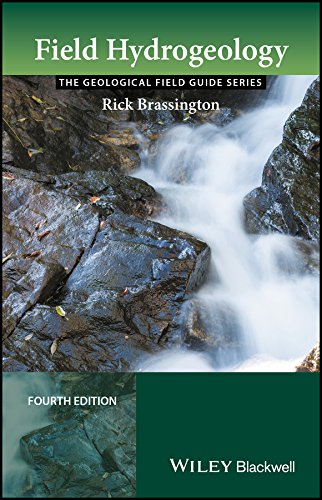All books / Book
Field Hydrogeology (Geological Field Guide)

| Full title: | Field Hydrogeology (Geological Field Guide) |
|---|---|
| ISBN: | 9781118397367 |
| ISBN 10: | 1118397363 |
| Authors: | Brassington, Rick |
| Publisher: | Wileyblackwell |
| Edition: | 4 |
| Num. pages: | 312 |
| Binding: | Paperback |
| Language: | en |
| Published on: | 2017 |
Read the reviews and/or buy it on Amazon.com
Synopsis
Featuring Case Histories And Focusing On Practical Applications, This Invaluable Resource Follows A Systematic Approach To Completing A Hydrogeological Study And Explains How To Decide On The Measurements That Are Needed And On The Instruments And Techniques Required. -- The Geological Field Guide Series; Title Page; Copyright; Table Of Contents; Dedication; Preface; Acknowledgements; Chapter 1: Introduction; 1.1 Groundwater Systems; 1.2 Conceptual Model; 1.3 Groundwater Computer Modelling; 1.4 Hydrogeological Report Writing; 1.5 Expert Witness; Chapter 2: Desk Study; 2.1 Defining The Area; 2.2 Identifying The Aquifers; 2.3 Groundwater Levels; 2.4 Surface Water; 2.5 Recharge; 2.6 Groundwater Use; 2.7 Groundwater Chemistry; 2.8 Aerial Photographs And Satellite Imagery; 2.9 Planning A Fieldwork Programme; Chapter 3: Field Evaluation Of Aquifers 3.1 Grain Size Analysis3.2 Hydraulic Properties Of Aquifers; 3.3 Hydraulic Properties And Rock Types; 3.4 Assessing Hydraulic Properties; 3.5 Using Hydraulic Property Information; Chapter 4: Groundwater Levels; 4.1 Water-level Dippers; 4.2 Continuous Water-level Recorders; 4.3 Measuring Ground Levels And Locations; 4.4 Tool-box; 4.5 Well Catalogue; 4.6 Field Surveys For Wells, Boreholes And Springs; 4.7 Interpretation Of Abstraction Borehole Water Levels; 4.8 Groundwater-level Monitoring Networks; 4.9 Groundwater-level Fluctuations; 4.10 Managing Groundwater-level Data 4.11 Constructing Groundwater Contour Maps And Flow Nets4.12 Interpretation Of Contour Maps And Flow Nets; 4.13 Using Other Groundwater Information; Chapter 5: Rainfall, Springs And Streams; 5.1 Precipitation; 5.2 Evaporation; 5.3 Springs; 5.4 Stream-flow Measurement; 5.5 Stage-discharge Relationships; 5.6 Choosing The Best Method; 5.7 Processing Flow Data; Chapter 6: Pumping Tests; 6.1 What Is A Pumping Test?; 6.2 Planning A Pumping Test; 6.3 Pumps And Pumping; 6.4 On-site Measurements; 6.5 Pre-test Monitoring; 6.6 Test Set-up; 6.7 Step Tests; 6.8 Constant Rate Tests; 6.9 Recovery Tests 6.10 Pumping Test Analysis6.11 Tests On Single Boreholes; 6.12 Packer Tests; Chapter 7: Groundwater Chemistry; 7.1 Analytical Suites And Determinands; 7.2 Sampling Equipment; 7.3 Sampling Protocols; 7.4 Monitoring Networks; 7.5 Using Chemical Data; Chapter 8: Recharge Estimation; 8.1 Water Balance; 8.2 Rainfall Recharge; 8.3 Induced Recharge; 8.4 Other Sources Of Recharge; Chapter 9: Specialist Techniques; 9.1 Borehole And Piezometer Installation; 9.2 Down-hole Geophysics; 9.3 Using Artificial Tracers; Chapter 10: Practical Applications; 10.1 Borehole Prognoses; 10.2 Groundwater Supplies 10.3 Wells In Shallow Aquifers10.4 Contaminated Land Investigations; 10.5 Landfills And Leachate; 10.6 Geothermal Energy; 10.7 Groundwater Lowering By Excavation; 10.8 Rising Water Tables; 10.9 Soakaways; 10.10 Investigating Wetland Hydrology; Appendix A: Good Working Practice; A1.1 Safety Codes; A1.2 Safety Clothing And Equipment; A1.3 Distress Signals; A1.4 Exposure Or Hypothermia; A1.5 Heat Exhaustion; A1.6 Working Near Wells, Boreholes And Monitoring Piezometers; A1.7 Hygiene Precautions For Water Supplies; A1.8 Trial Pits; A1.9 Electrical Equipment; A1.10 Filling Fuel Tanks Rick Brassington. Includes Bibliographical References And Index. Mode Of Access: World Wide Web.